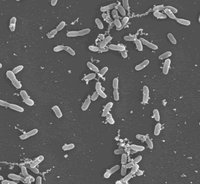
Siberian permafrost with its continual low temperatures (-10°C) and associated decreased water activity is seen as a model environment for assessing potential survival mechanisms of life on astral bodies. Ice formation increases solute concentration by decreasing the amount of free water available in the remaining unfrozen water films (aw=0.85-0.9), making this condition even more stressful to microbial cells. The majority of permafrost isolates grow under increased osmotica, in addition to temperatures as low as 10°C.
To gain knowledge of the features for adaptation to low temperature and water activity, the genome of a Siberian permafrost isolate was sequenced. Psychrobacter 273-4, a gamma-Proteobacterium grows at temperatures as low as 10°C and displays marked physiological changes under low temperature vs. mesophilic growth and in the presence of increased osmotica (salt). Known cold and salt responsive genes are present in the genome. Differential gene expression analyses, using microarrays specific for the predicted genes of Psychrobacter 273-4, at 4°C and 22°C reveal 2-fold or greater up-regulation at 4°C for a number of genes necessary for energy metabolism and maintenance of membrane fluidity. Several transport genes and potential amino acid metabolism operons, implicated in compatible solute production in other bacteria are differentially expressed. The expression patterns of these transport genes support physiological evidence that different carbon sources are utilized at the two temperatures. The majority of genes down-regulated (2-fold or greater) when grown in the presence of 5% NaCl are involved in cation transport, indicating a systemic response to limit NaCl transport into the cell. Up-regulation of a gene predicted to be involved in cell shape correlates with increased cell size in the presence of 5% NaCl. In addition, general stress response chaperones are upregulated under both increased salinity and decreased temperatures. Several genes with unknown functions are upregulated under both stresses, indicating their possible importance in stress survival. The gene expression profiles and physiological responses of Psychrobacter 273-4 to low temperature and increased osmotica indicate that they have adapted to the low water activity and subzero temperatures of the permafrost environment.
 A Record of the Earliest (4.5-3.8 Ga) Surface Conditions on Earth?
A Record of the Earliest (4.5-3.8 Ga) Surface Conditions on Earth? Simulating Groundwater Radiolysis With Oxidation of Pyrite by Hydrogen Peroxide Solution
Simulating Groundwater Radiolysis With Oxidation of Pyrite by Hydrogen Peroxide Solution Exploring Planet-Forming and Debris Disks
Exploring Planet-Forming and Debris Disks Quantifying Water Production in Comets - The "Meter Stick" for Their Chemical Taxonomy
Quantifying Water Production in Comets - The "Meter Stick" for Their Chemical Taxonomy